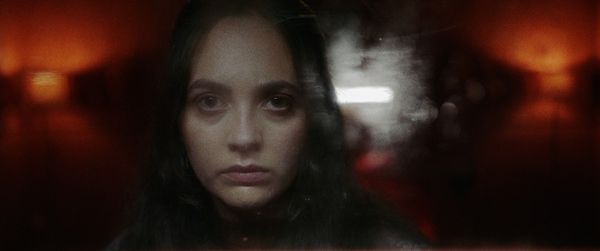Eye For Film >> Movies >> Red Room (2021) Film Review
Red Room
Reviewed by: Andrew Robertson

Based on a novel, Bryan M Ferguson's film Red Room starts with two technologies on either side of movable type. The woods, deep and trackless. A studio, a filament deposit manufacturing rig, a 3D printer. Between the latter and a bedroom, a phone call.
On either side, detail. Orange gloves, nitrile. Tarot cards, spread. "I don't want to talk about the red room," he says, then they're talking about reproduction. About copies. Those serried ranks of sisterly stems, the fraternal boughs of biological brotherhood. The words one sound at a time. Preservation. Avoiding things becoming lost.
Where is the when? It's a bright blue Ford from the period between automated assembly and side impact protection. A 1977 Cortina, from the era where petrol had lead and nobody would knock it. The telephones are landlines. That spread of cards has in its glossiness a sense less of Rider-Waite than Android.
What is the everyday carry of a creature from the woods? One that looks cold. One with an edge. Let us through the red doorway and find out. Let its redness fill the screen, become the sheets that hold us in our sleep, the walls that enclose us in our dread.
Based on Bitterhall by Helen McLory, this is another showcase for Ferguson's technique, his very distinctive eye. To have induced distress to the point that audiences have fainted is a signal of how far he will push things. The squealing tone in the red room carries on long enough to move beyond discomfort. It is a tone that can almost shatter glass.
I was prompted to seek out the novel and in it found tonal cousin, a work itself about self and replication. Of the Northern Lights the (here un-named) James Lennoxlove of Bitterhall (long dead, recently imagined) reflects "a marvellous fabric high in the evening sky like fairies dancing in luminous green skirts" (p.39), and in that stolen memoir a recollection predicated upon other kingdoms. Thresholds and barriers, the arcane arcs of mycelium geometry and the auroral sparks of magnetospheric geography.
The novel has within it elements of imperfect replication. That 3-D printer in the opening has a larger literary echo, or indeed is a skeletonised successor to its printed prototype. "'The loom of all things,'" it is called (p.36), "ink canisters that [they] mix to recreate the exact types used in the object [they] want to replicate. Inks from medieval Europe, Japan, and so on." (ibid) One of then named Kells, for that work itself. A beast is recreated in the machine, but the secrets within it are imperfectly reproduced, matching in some observable attributes but not in others. "'The best estimate of the machine', [he] said" (p.37), but even then I am not solely quoting the book (978 1 48697 549 3 in hard copy) but a photograph (of several) I took of relevant pages, it being easier to grab an electronic version of a non-electronic version than try to wrangle an eBook onto one of the various devices whose black mirrors reflect worlds I do and do not inhabit.
It is, I think, Glasgow, soundstage, not architectural digest Edinburgh millionaire's home, but the sense of that Red Room is still there. Moments, a succession thereof, a sequence of interpolation that resembles the clacking of Baudrillard at the billiards table. It was Clarke who suggested that a sufficiently advanced technology was indistinguishable from magic but he did so in a medium where trees are bleached into thin slices and marked with varnishes made from aeon-dead creatures that bind pigments to them, all the better to conjure imagery in the minds of those that stare upon them.
I would not speculate as to whether Ferguson himself had held the copy I held, nor returned it to avoid a late charge from Glasgow Life Libraries. I can say that he found something within it that takes from it not just a haunting but a willingness to be haunted. Has from a suite found single rooms that serve as stations not of the cross but definitely of a journey. One to a place that is perhaps as much rebirth, with some measure of suffering along its own dolorous way.
Similarly breaking with source, Ferguson makes the film itself an unreliable narrator. The performances by Flora Bird (Orla), Angus Yellowlees (Daniel) and Conor Mainwaring (Tom) are almost entirely separate. That they may or may not intersect with that of Paul Michael Henry (labelled only as The Figure) is part of the rule of three. Three objects, three participants, three acts, perhaps. Three senses of remove, at least.
Paul Preston's music is heavy with deep strings, electric in places as is the tension. I now find it difficult to separate the film from its source; in reading one I had in mind the other. A lens by any other name. That tension of truths is present, a refractive reflection.
Reviewed on: 25 Jul 2022














